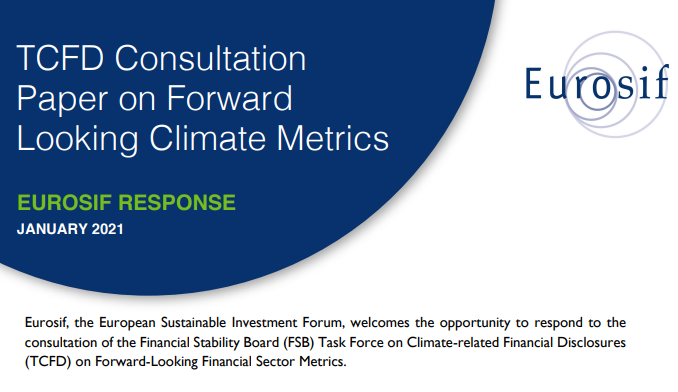Eurosif responds to the the FSB Task Force on Climate-related Financial Disclosure (TCFD) public consultation
Forward-looking metrics could have a key role to play in the race to Net-Zero ahead of COP 26 with improvements on GHG emissions data, standardised climate scenarios and clear transition pathways for the key economic sectors. Today, Eurosif responded to the Financial Stability Board TCFD consultation on forward-looking metrics.
Ahead of the COP 26 later this year, the race is on to reach climate neutrality objective of Net-Zero by 2050. Asset owners and asset managers are starting to use forward-looking climate metrics and different methodologies to ensure a gradual alignment of their investment portfolios with this net-zero objective.
To ensure these metrics become decision-useful for investors, a number of steps will need to improve:
- Better data on GHG Emissions - The accuracy of forward-looking metrics depends entirely on the quality of GHG emissions data underpinning them. While aiming for perfection is good, it would already be good to get standardisation around the relevance of Scope 1, 2, 3 and possibly for different economic sectors.
- Climate scenarios and transition pathways - Since these metrics are inherently forward-looking, the relevance of these metrics depends on the climate scenarios and transition pathways used to compute the results. Technically accurate metrics based on unrealistic or flawed scenarios and transition pathways for certain key sectors (energy, transportation, manufacturing, real estate, agriculture) will not be decision-useful.
- Make use of the right metrics - Not all forward-looking metrics are equally decision-useful to investors. In general, we would avoid metrics that look to combine carbon intensity or carbon footprint with economic values such as the value of investments or revenues. These metrics could artificially drive investors towards shares of companies with traditionally low carbon business models (e.g. pharmaceuticals vs transport), while neglecting shares in high-emitting sectors. However, it is exactly the transition of these high-emitting sectors that will determine whether or not we will achieve the race to net-zero. To avoid this, we recommend that company-specific forward-looking climate metric should compare between companies within the same industry and versus the industry-specific transition pathway to achieve net-zero.
Read our entire press release: PRESS RELEASE Eurosif on FSB-TFCD
Read our full answer: FULL RESPONSE Eurosif to FSB TCFD Consultation Forward Looking Climate Metrics

